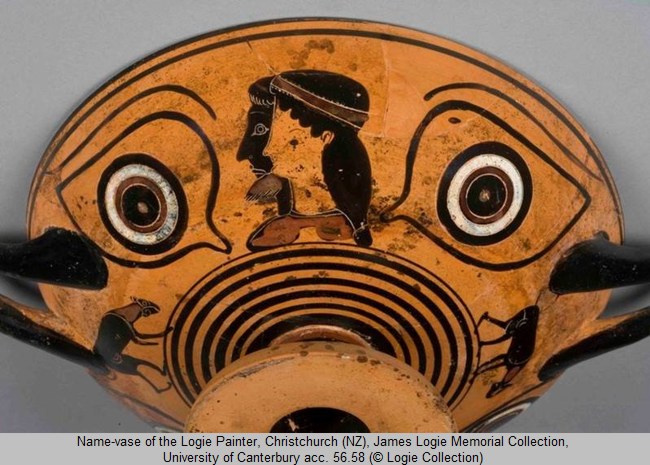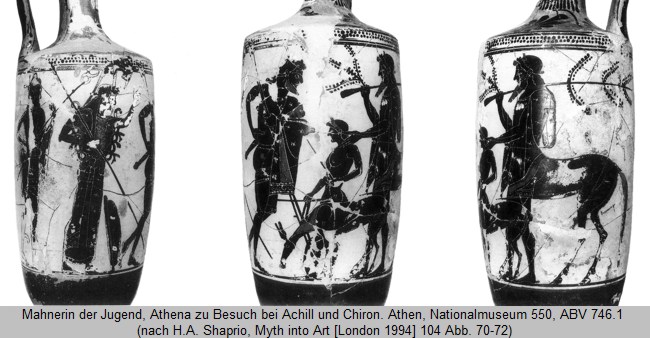
AMBIGUITY AND CLARITY – MEHRDEUTIGKEIT UND EINDEUTIGKEIT
What Can Owl-skyphoi Transmit?
Anastasia Bukina (St. Petersburg, RU)
Owl-skyphoi are a kind of mass-produced Attic red-figure vases of the 5th century BC, much studied by F.P. Johnson, J.D. Beazley, A.D. Trendall, O.V. Tugusheva, B. Kreuzer and others. Widespread in the Mediterranean, owl-skyphoi could transmit all over the oecumene the imperial prestige of Athens. The non-authorized copies made in Corinth, Laconia, elsewhere in Greece as well as Magna Graecia allow us to assume that everybody could understand their connotation. The simplicity of the standard depiction with the owl between a pair of olive twigs could be compared with any modern logo, understandable even without any details, communicated by visual or narrative means. However, the meticulous study of the owl-skyphoi allow us to discover separate series of them, painted at a particular time, in a particular workshop, by a particular hand and even depicting different small species of owls. It could represent a case study for an understanding of the interrelation of artistic minimalism and the deep-seated roots of folklore symbolism in a common form of red-figure vase painting in Athens of the 5th century.
e-mail: bukina@genuinepearl.spb.ru
Polysemy in the Attic Black-figure Vase-painting Tradition
Anne Mackay (Auckland, NZ)
This paper will argue that polysemy is an essential and pervasive characteristic of the Attic black-figure vase-painting tradition. As is now well recognised in scholarship, the sharp distinction between daily life and mythology is largely a modern construct. It is therefore unlikely to have been an issue for the painters and their contemporaries, whose semiotic register encompassed a seamless continuum from myth through cult activity to lived experience. The images on vases that are often classed as ambiguous or even indeterminable in the scholarship should therefore rather be analysed according to the principle that they could – and did – present themselves as the basis for diverse, and even contrastive, significations that were all simultaneously evoked by the image in its context within the tradition: this is not to imply alternative interpretations (which would constitute ambiguity), but rather, the images are polysemic, whereby the multiple meanings were simultaneously (re-)constructed and understood as conjointly expressing the ancient perception of a world in which the natural was perfused with the supernatural and entirely consonant with it.

This concept is challenging to demonstrate, because it requires us to access a receptive and perceptive system that is alien to our tendency to expect an image from another culture to be a constant signifier with a relatively fixed and limited range of meaning: comparable is the notorious difficulty of translating a double entendre from one language to another (the double entendre is in fact often advanced to exemplify polysemy, where again the meaning arises precisely from the simultaneous recognition of two different significations from different registers). Nevertheless, there are some sets of examples in black-figure where the polysemic character can be demonstrated persuasively. The head cups of the second half of the sixth century are one such group, where the varying inscriptions on some vessels suggest a polysemic signification in others. Some other sets of black-figure figures or scenes will be discussed briefly in support of the suggestions that polysemy is a widely applicable phenomenon in the black-figure tradition (and indeed it seems to have been generally inherent in the imagery of early Greece).
e-mail: anne.mackay@auckland.ac.nz
Vasenbilder in doppelter Funktion: bemalte Pinakes und andere Miniaturgemälde auf attischen rotfigurigen Vasen
Eleni Manakidou (Thessaloniki, GR)
Die Darstellung von bemalten Gegenständen auf attischen Vasen ist nicht so häufig und sie wird hauptsächlich auf bestimmte Gattungen von Objekten beschränkt. Zunächst kommen die abgebildeten Vasen selbst, welche manchmal mit Miniaturbildern verziert sind, danach die Gewänder und Textilien aller Art, auf denen oft figürliche Szenen angebracht werden; schließlich sind gelegentlich bildliche Motive auch auf den dargestellten architektonischen Teilen und Tafeln (Pinakes) im Rahmen eines narrativen oder repräsentativen Vasenbildes zu finden. Diese ‚Vignetten‘ können Träger vielfältiger Botschaften und helfende Hinweise zur Deutung der Hauptszenen sein.
Dazu werden wir ein ungewöhnliches ikonographisches Thema betrachten, welches mit der Abbildung von sakralen Landschaften in der attischen rotfigurigen Vasenmalerei zu tun hat und besonders in zwei Varianten vorkommt: mit oder ohne menschliche Teilnehmer; in bei-den Fällen sind aber bemalte Tafeln (Pinakes) zusammen mit einer Ansammlung von rituellen und anderen Objekten abgebildet. Die menschenleeren Szenen können wir als ‚Stillleben‘ bezeichnen und sie bilden eine relativ kleine, homogene aber zugleich ungewöhnliche Vasengruppe.
e-mail: hmanak@hist.auth.gr
A Woman in Danger or a Dangerous Woman? ‘Helen’ on Archaic Attic Vases
Samantha Masters (Stellenbosch, ZA)
The popularity of ancient Greek myths as subject matter on vases – as well as topics for poets – was not only because they were interesting stories, but more particularly because of their availability as paradigms of human behaviour and human/social dynamics. It is likely too, that the repetition of certain image configurations in the repertoire of Attic vase-painters was only partly because they were expedient, or successful visually, and more because their subject communicated with the viewer/s on a variety of levels. A group of Attic black-figure scenes from the 6th century BC that have been described by Lily Ghali-Kahil (LIMC IV, s.v. Hélène) as Helen’s abduction by Paris, or her recovery by Menelaus, provides a useful case study. These scenes are characterised by a repeated image matrix: a heavily armed hoplite confronts or leads a passive veiled woman away, while onlookers (male and female) attend, and gesture in different ways. On the narrative level these scenes may well represent the famous Helen with one of her husbands, as Ghali-Kahil suggests. Inscriptional and iconographic evidence is inconclusive, but does not exclude a narrative and mythological explanation for the scenes. However, there is much that the scenes can also communicate on the level of metanarrative, especially about the precarious position of an unreliable woman like Helen (and, by extension, all women).
In this paper I will examine the messages implied in such black-figure ‘Helen’ scenes, and especially, the modes of communication at play. Key to understanding this imagery is its polysemy; the interpreter must allow for several plausible readings based on careful recon-textualisation of the images and consideration of the horizon of expectations of the ancient viewer/s. The approach presented in this paper will demonstrate how a successful image matrix can be a useful communicative tool through which the artist and his ‘audience’ can respond to their world.
e-mail: masters@sun.ac.za
Athena als Kommunikationsmittel in Bildern mythischer Helden in der attischen Vasenmalerei
Antonia Rüth (Freiburg, DE)
Für das Selbstverständnis der antiken, griechischen Gesellschaft waren Götter und Heroen von zentraler Bedeutung. Auf Vasenbildern treten sie oftmals gemeinsam auf.
Unter den Göttern, die zusammen mit den Heroen agieren, ist Athena mit Abstand am häufigsten zu finden. Dabei hebt sie sich von den übrigen Gottheiten nicht nur durch ihre scheinbare Omnipräsenz ab. Denn im Gegensatz etwa zu Apollon und Hephaistos, die zusammen mit ihren Priestern auftreten, oder Aphrodite, Poseidon und Thetis mit ihren Kindern, ist Athenas Anwesenheit auf den Bildern, die sie beispielsweise mit Herakles, Achill oder Perseus zeigen, nicht durch ihr eigenes Interesse motiviert. Noch ist ihr Auftreten in den wenigsten Fällen aus narrativer Sicht für das Verständnis des Bildmotivs zwingend erforderlich.
Diese und weitere Beobachtungen legen nahe, dass die Vasenmaler in ihren Bildern die Göttin als Kommunikationsmittel einsetzten und die Bedeutung ihrer Anwesenheit in diesen weit über das hinausgeht, was in der bisherigen Forschung zumeist lediglich knapp als ‚Beistandsgöttin‘ formuliert wurde.
In dem Vortrag soll den Fragen nachgegangen werden, wie Athena in den Vasenbildern als Kommunikationsmittel genutzt wurde und welche Einblicke dadurch in das Selbstverständnis der athenischen Gesellschaft gewährt werden.
e-mail: toni_rueth@hotmail.com

This article should be cited like this: C. Lang-Auinger - E. Trinkl, Griechische Vasen als Kommunikationsmedium / Greek Vases as Medium of Communication, Forum Archaeologiae 84/IX/2017 (http://farch.net).


